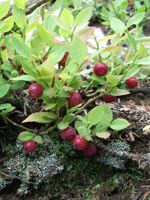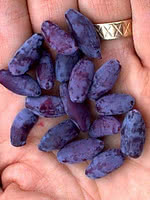Mon-Fri 9am - 5pm Mountain time
Berry Blue Haskap (Honeyberry) vs Grouseberry
Vaccinium scoparium
Lonicera caerulea Berry Blue
CUSTOM GROW
NOT AVAILABLE THIS SEASON - MIGHT RETURN
Grouseberry is a native, low-growing deciduous shrub known for its edible red berries. In early summer, it produces small, urn-shaped flowers ranging from white to pink that attract bees and other pollinators. The berries provide an important food source for many types of wildlife, including game birds such as grouse, which gives the plant its common name. People can also enjoy the berries fresh or in baked goods, though they can be difficult to harvest in large quantities.
Spreading by rhizomes, Grouseberry forms dense, broom-like mats that help stabilize soil and prevent erosion, while also providing cover for ground-nesting wildlife. It is commonly found beneath conifers in open forests, subalpine meadows, and occasionally on rocky slopes in mountainous regions. It is well-suited for naturalization, ecological restoration, and soil stabilization projects.
Berry Blue Honeyberry is a hardy deciduous shrub. Its fruit is deliciously tart and perfect for fresh eating or production.
Berry Blue is an early pollinating variety. Pair with other early pollinators to have a higher yield.
Aurora is a great companion variety.
Haskap is the Japanese name for these berries and this term has been adopted for the University of Saskatchewan varieties. In other areas they are more commonly known as Honeyberry which is why we call this Eastern European variety Honeyberry.

